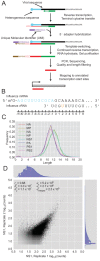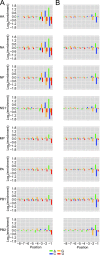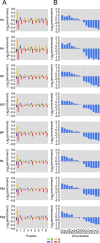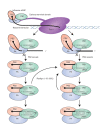Sequencing the cap-snatching repertoire of H1N1 influenza provides insight into the mechanism of viral transcription initiation
- PMID: 25901029
- PMCID: PMC4446424
- DOI: 10.1093/nar/gkv333
Sequencing the cap-snatching repertoire of H1N1 influenza provides insight into the mechanism of viral transcription initiation
Abstract
The influenza polymerase cleaves host RNAs ∼10-13 nucleotides downstream of their 5' ends and uses this capped fragment to prime viral mRNA synthesis. To better understand this process of cap snatching, we used high-throughput sequencing to determine the 5' ends of A/WSN/33 (H1N1) influenza mRNAs. The sequences provided clear evidence for nascent-chain realignment during transcription initiation and revealed a strong influence of the viral template on the frequency of realignment. After accounting for the extra nucleotides inserted through realignment, analysis of the capped fragments indicated that the different viral mRNAs were each prepended with a common set of sequences and that the polymerase often cleaved host RNAs after a purine and often primed transcription on a single base pair to either the terminal or penultimate residue of the viral template. We also developed a bioinformatic approach to identify the targeted host transcripts despite limited information content within snatched fragments and found that small nuclear RNAs and small nucleolar RNAs contributed the most abundant capped leaders. These results provide insight into the mechanism of viral transcription initiation and reveal the diversity of the cap-snatched repertoire, showing that noncoding transcripts as well as mRNAs are used to make influenza mRNAs.
© The Author(s) 2015. Published by Oxford University Press on behalf of Nucleic Acids Research.
Figures






Similar articles
-
Insight into Influenza: A Virus Cap-Snatching.Viruses. 2018 Nov 16;10(11):641. doi: 10.3390/v10110641. Viruses. 2018. PMID: 30453478 Free PMC article. Review.
-
Influenza A virus preferentially snatches noncoding RNA caps.RNA. 2015 Dec;21(12):2067-75. doi: 10.1261/rna.054221.115. Epub 2015 Oct 1. RNA. 2015. PMID: 26428694 Free PMC article.
-
Rice Stripe Tenuivirus Has a Greater Tendency To Use the Prime-and-Realign Mechanism in Transcription of Genomic than in Transcription of Antigenomic Template RNAs.J Virol. 2017 Dec 14;92(1):e01414-17. doi: 10.1128/JVI.01414-17. Print 2018 Jan 1. J Virol. 2017. PMID: 29046442 Free PMC article.
-
Influenza A virus cap-snatches host RNAs based on their abundance early after infection.Virology. 2017 Sep;509:167-177. doi: 10.1016/j.virol.2017.06.020. Epub 2017 Jun 22. Virology. 2017. PMID: 28646652
-
Interplay between Influenza Virus and the Host RNA Polymerase II Transcriptional Machinery.Trends Microbiol. 2019 May;27(5):398-407. doi: 10.1016/j.tim.2018.12.013. Epub 2019 Jan 11. Trends Microbiol. 2019. PMID: 30642766 Free PMC article. Review.
Cited by
-
Anthralin Suppresses the Proliferation of Influenza Virus by Inhibiting the Cap-Binding and Endonuclease Activity of Viral RNA Polymerase.Front Microbiol. 2020 Feb 18;11:178. doi: 10.3389/fmicb.2020.00178. eCollection 2020. Front Microbiol. 2020. PMID: 32132985 Free PMC article.
-
Cryo-EM structures of Thogoto virus polymerase reveal unique RNA transcription and replication mechanisms among orthomyxoviruses.Nat Commun. 2024 May 30;15(1):4620. doi: 10.1038/s41467-024-48848-3. Nat Commun. 2024. PMID: 38816392 Free PMC article.
-
Inhibition of Ongoing Influenza A Virus Replication Reveals Different Mechanisms of RIG-I Activation.J Virol. 2019 Mar 5;93(6):e02066-18. doi: 10.1128/JVI.02066-18. Print 2019 Mar 15. J Virol. 2019. PMID: 30602605 Free PMC article.
-
Insight into Influenza: A Virus Cap-Snatching.Viruses. 2018 Nov 16;10(11):641. doi: 10.3390/v10110641. Viruses. 2018. PMID: 30453478 Free PMC article. Review.
-
The Cap Snatching of Segmented Negative Sense RNA Viruses as a Tool to Map the Transcription Start Sites of Heterologous Co-infecting Viruses.Front Microbiol. 2017 Dec 14;8:2519. doi: 10.3389/fmicb.2017.02519. eCollection 2017. Front Microbiol. 2017. PMID: 29312219 Free PMC article.
References
-
- Hamm J., Mattaj I.W. Monomethylated cap structures facilitate RNA export from the nucleus. Cell. 1990;63:109–118. - PubMed
Publication types
MeSH terms
Substances
Associated data
- Actions
Grants and funding
LinkOut - more resources
Full Text Sources
Other Literature Sources
Molecular Biology Databases
Miscellaneous

